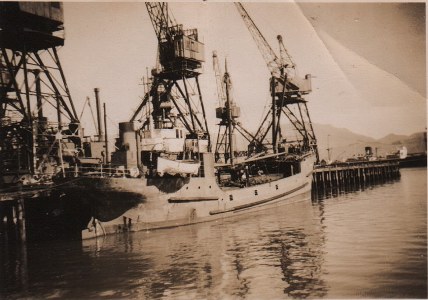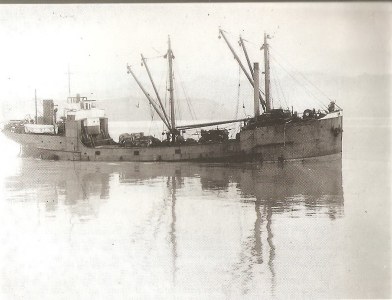The Ultimate New Zealand Soccer Website | home
Gael | Gamma | Guardian Carrier | Ha'amotaha | Hauiti | Hauturu | Hawea | Hokianga | Holmbank | Holmbrae | Holmburn | Holmburn | Holmdale | Holmglen | Holmglen | Holmlea | Holmlea | Holmpark | Holmwood | Hotunui | Hunte | Ile De Lumiere | Inaha | Induna | Inger Riis | Inparma Progress | Jackson Bay | Jaguar | James M Cook | Jaya No. 6 | Jean Philippe | Jill Coast | Josephine | Kaapgracht | Kaitoa | Kali | Karepo | Karetu
Holmglen
 Sourced from NZ Coastal Shipping Forum
|
||||||||||||||||||||
Built in Foxhol, Holland, for the Baltic trade, she was acquired by Mercer's Roose Shipping Company but was swiftly transferred to Holm Shipping. She sailed from Cardiff to Georgetown, Trinidad, on her delivery voyage to New Zealand, picking up a load of bitumen for discharge upon her arrival in Wellington in March 1932, when she was renamed "Holmglen".
Nicknamed "The Boot" because of her shape, her bows were semi-circular as opposed to the traditional pointed appearance. Tramlines had been welded under her deck to strengthen her. She began life with a boiler and a funnel on deck forward to drive her steam winches, which were later replaced by motor winches.
She traded between South Island ports and Wellington, New Plymouth and Port Waikato, with occasional calls at Onekaka to load dolomite. When bar issues ruled out calls to Port Waikato in 1940, 'twas to Raglan she headed.
She made a rare call at Onehunga in April 1951, by which time she sported a permanent kink in her stem, not unlike a broken nose - a war wound from a collision.
Soon after she was sold to interests in Port Vila, New Hebrides. She operated in and around that area of the world until 6 September 1967, when she sank after breaking down en route from Port Vila to Port Narevia. Her main engine connecting rod snapped and gashed a hole in the hull which her pumps were incapable of handling. Her crew abandoned ship and landed safely at Dillon's Bay, Erromanga.
 From the Lyttleton Museum collection, as published in NZ Marine News' 1993 publication, Volume 42 Quarter 4
|